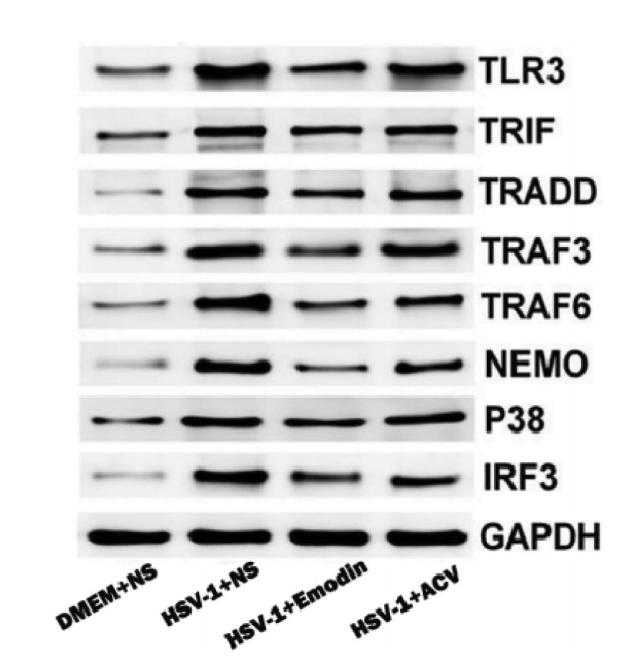TLR3 Antibody - #DF6415
| Product: | TLR3 Antibody |
| Catalog: | DF6415 |
| Description: | Rabbit polyclonal antibody to TLR3 |
| Application: | WB IHC |
| Cited expt.: | WB, IHC |
| Reactivity: | Human, Mouse, Rat |
| Prediction: | Bovine, Horse, Sheep, Rabbit |
| Mol.Wt.: | 99kDa,130kd(Glycosylation); 104kD(Calculated). |
| Uniprot: | O15455 |
| RRID: | AB_2838378 |
Related Downloads
Protocols
Product Info
*The optimal dilutions should be determined by the end user. For optimal experimental results, antibody reuse is not recommended.
*Tips:
WB: For western blot detection of denatured protein samples. IHC: For immunohistochemical detection of paraffin sections (IHC-p) or frozen sections (IHC-f) of tissue samples. IF/ICC: For immunofluorescence detection of cell samples. ELISA(peptide): For ELISA detection of antigenic peptide.
Cite Format: Affinity Biosciences Cat# DF6415, RRID:AB_2838378.
Fold/Unfold
CD283; CD283 antigen; IIAE2; TLR 3; Tlr3; TLR3_HUMAN; Toll Like Receptor 3; Toll-like receptor 3;
Immunogens
A synthesized peptide derived from human TLR3, corresponding to a region within C-terminal amino acids.
Expressed at high level in placenta and pancreas. Also detected in CD11c+ immature dendritic cells. Only expressed in dendritic cells and not in other leukocytes, including monocyte precursors. TLR3 is the TLR that is expressed most strongly in the brain, especially in astrocytes, glia, and neurons.
- O15455 TLR3_HUMAN:
- Protein BLAST With
- NCBI/
- ExPASy/
- Uniprot
MRQTLPCIYFWGGLLPFGMLCASSTTKCTVSHEVADCSHLKLTQVPDDLPTNITVLNLTHNQLRRLPAANFTRYSQLTSLDVGFNTISKLEPELCQKLPMLKVLNLQHNELSQLSDKTFAFCTNLTELHLMSNSIQKIKNNPFVKQKNLITLDLSHNGLSSTKLGTQVQLENLQELLLSNNKIQALKSEELDIFANSSLKKLELSSNQIKEFSPGCFHAIGRLFGLFLNNVQLGPSLTEKLCLELANTSIRNLSLSNSQLSTTSNTTFLGLKWTNLTMLDLSYNNLNVVGNDSFAWLPQLEYFFLEYNNIQHLFSHSLHGLFNVRYLNLKRSFTKQSISLASLPKIDDFSFQWLKCLEHLNMEDNDIPGIKSNMFTGLINLKYLSLSNSFTSLRTLTNETFVSLAHSPLHILNLTKNKISKIESDAFSWLGHLEVLDLGLNEIGQELTGQEWRGLENIFEIYLSYNKYLQLTRNSFALVPSLQRLMLRRVALKNVDSSPSPFQPLRNLTILDLSNNNIANINDDMLEGLEKLEILDLQHNNLARLWKHANPGGPIYFLKGLSHLHILNLESNGFDEIPVEVFKDLFELKIIDLGLNNLNTLPASVFNNQVSLKSLNLQKNLITSVEKKVFGPAFRNLTELDMRFNPFDCTCESIAWFVNWINETHTNIPELSSHYLCNTPPHYHGFPVRLFDTSSCKDSAPFELFFMINTSILLIFIFIVLLIHFEGWRISFYWNVSVHRVLGFKEIDRQTEQFEYAAYIIHAYKDKDWVWEHFSSMEKEDQSLKFCLEERDFEAGVFELEAIVNSIKRSRKIIFVITHHLLKDPLCKRFKVHHAVQQAIEQNLDSIILVFLEEIPDYKLNHALCLRRGMFKSHCILNWPVQKERIGAFRHKLQVALGSKNSVH
Predictions
Score>80(red) has high confidence and is suggested to be used for WB detection. *The prediction model is mainly based on the alignment of immunogen sequences, the results are for reference only, not as the basis of quality assurance.
High(score>80) Medium(80>score>50) Low(score<50) No confidence
Research Backgrounds
Key component of innate and adaptive immunity. TLRs (Toll-like receptors) control host immune response against pathogens through recognition of molecular patterns specific to microorganisms. TLR3 is a nucleotide-sensing TLR which is activated by double-stranded RNA, a sign of viral infection. Acts via the adapter TRIF/TICAM1, leading to NF-kappa-B activation, IRF3 nuclear translocation, cytokine secretion and the inflammatory response.
Heavily N-glycosylated, except on that part of the surface of the ectodomain that is involved in ligand binding.
TLR3 signaling requires a proteolytic cleavage mediated by cathepsins CTSB and CTSH, the cleavage occurs between amino acids 252 and 346. The cleaved form of TLR3 is the predominant form found in endosomes.
Endoplasmic reticulum membrane>Single-pass type I membrane protein. Endosome membrane. Early endosome.
Expressed at high level in placenta and pancreas. Also detected in CD11c+ immature dendritic cells. Only expressed in dendritic cells and not in other leukocytes, including monocyte precursors. TLR3 is the TLR that is expressed most strongly in the brain, especially in astrocytes, glia, and neurons.
ds-RNA binding is mediated by LRR 1 to 3, and LRR 17 to 18.
Belongs to the Toll-like receptor family.
Research Fields
· Cellular Processes > Cell growth and death > Necroptosis. (View pathway)
· Human Diseases > Infectious diseases: Viral > Hepatitis C.
· Human Diseases > Infectious diseases: Viral > Hepatitis B.
· Human Diseases > Infectious diseases: Viral > Influenza A.
· Human Diseases > Infectious diseases: Viral > Human papillomavirus infection.
· Human Diseases > Infectious diseases: Viral > Herpes simplex infection.
· Organismal Systems > Immune system > Toll-like receptor signaling pathway. (View pathway)
References
Application: WB Species: mouse Sample: macrophages
Application: IF/ICC Species: mouse Sample: nuclei
Application: WB Species: mouse Sample: brain
Application: IHC Species: mouse Sample: right temporal lobe brain
Application: WB Species: Mice Sample: brain tissues
Restrictive clause
Affinity Biosciences tests all products strictly. Citations are provided as a resource for additional applications that have not been validated by Affinity Biosciences. Please choose the appropriate format for each application and consult Materials and Methods sections for additional details about the use of any product in these publications.
For Research Use Only.
Not for use in diagnostic or therapeutic procedures. Not for resale. Not for distribution without written consent. Affinity Biosciences will not be held responsible for patent infringement or other violations that may occur with the use of our products. Affinity Biosciences, Affinity Biosciences Logo and all other trademarks are the property of Affinity Biosciences LTD.




